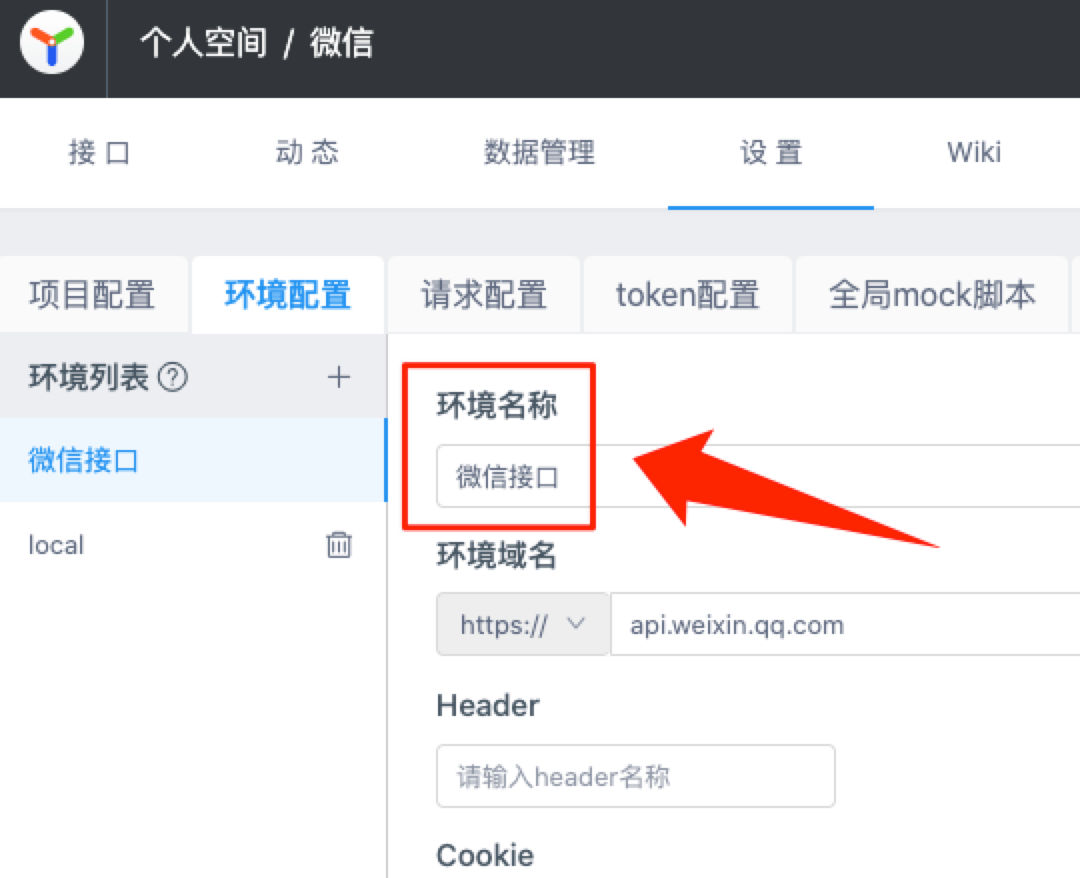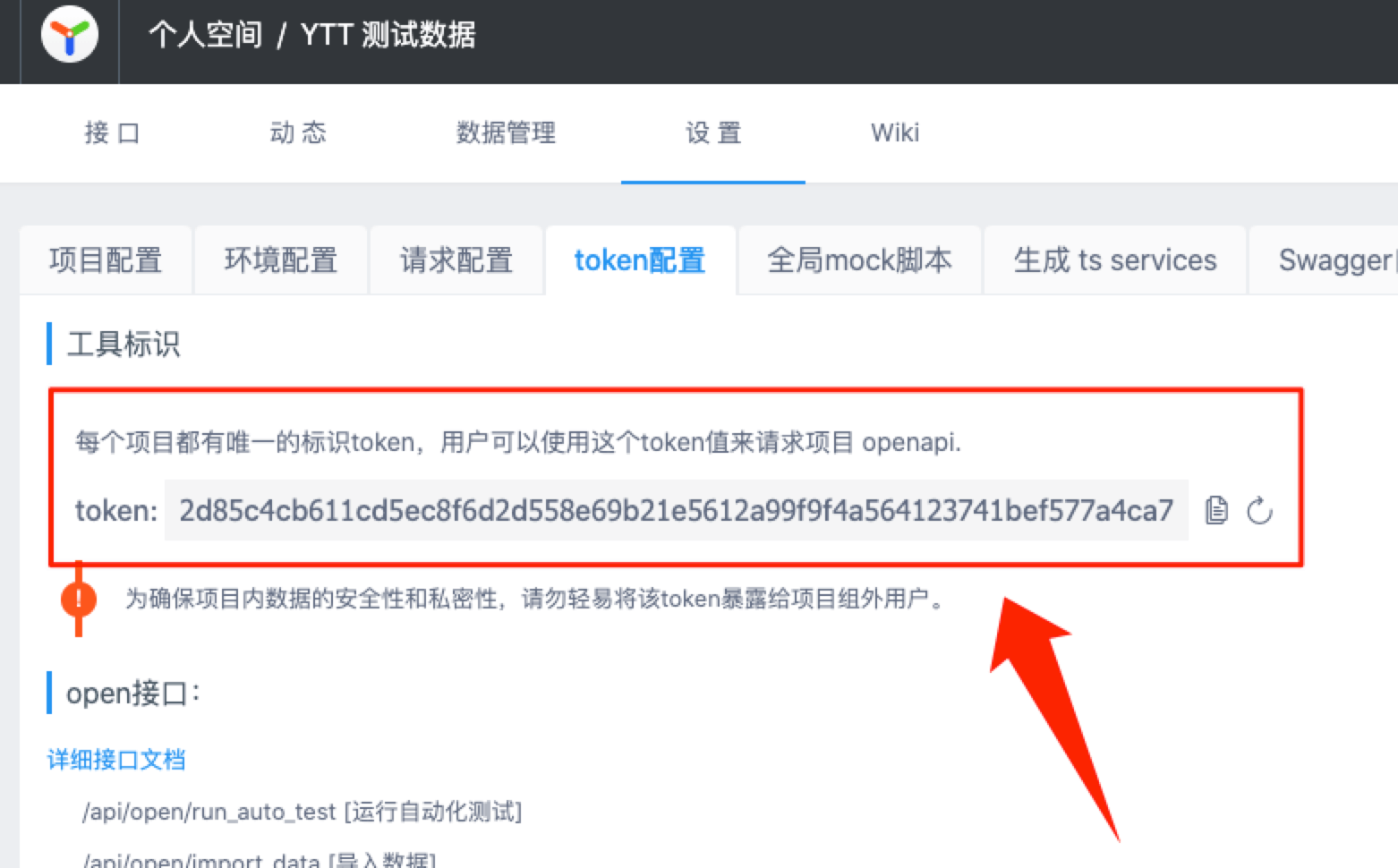配置
首先,使用以下命令初始化配置文件:
npx ytt init
然后,打开 ytt.config.ts 或 ytt.config.js 文件进行配置。
你还可以自定义配置文件的路径:
npx ytt init -c config/ytt.ts
公共配置
公共配置可以在服务器级别、项目级别、分类级别进行配置,如果存在相同的配置项,低级别的配置会覆盖高级别的配置。
target
- 类型:
'typescript' | 'javascript' - 默认值:
'typescript' - 说明:
要生成的目标代码类型。
typesOnly
- 类型:
boolean - 默认值:
false - 说明:
是否只生成接口请求内容和返回内容的 TypeSript 类型,是则请求文件和请求函数都不会生成。
devEnvName
- 类型:
string - 默认值:
(无) - 说明:
测试环境名称。用于获取测试环境域名。
获取方式:打开项目 -> 设置 -> 环境配置 -> 点开或新增测试环境 -> 复制测试环境名称。

prodEnvName
- 类型:
string - 默认值:
(无) - 说明:
生产环境名称。用于获取生产环境域名。
获取方式:打开项目 -> 设置 -> 环境配置 -> 点开或新增生产环境 -> 复制生产环境名称。

outputFilePath
- 类型:
string | ((interfaceInfo: Interface, changeCase: ChangeCase) => string) - 默认值:
(必填) - 说明:
输出文件路径。可以是 相对路径 或 绝对路径。如 'src/api/index.ts'。
3.22.0+ 你可以将之设置为函数实现类似接口分模块的需求:
import { defineConfig } from 'yapi-to-typescript'export default defineConfig({outputFilePath: interfaceInfo => `src/api/${interfaceInfo._category.name}.ts`,})
requestFunctionFilePath
- 类型:
string - 默认值:
与 outputFilePath 同级目录下的 request.ts 文件 - 说明:
请求函数文件路径。如 'src/api/request.ts'。
dataKey
- 类型:
string | string[] - 默认值:
(无) - 说明:
比如接口返回的数据形如:
{"code": 0,"msg": "success","data": {"id": 1,"name": "周杰伦"}}
作为具体业务,我们只关心 data 字段内的数据(code、msg 已经由请求函数统一处理),此时,可将 dataKey 设为 data,如此,生成的接口响应数据类型就是 data 字段的类型,必须注意的是,请求函数内需自行根据 payload.dataKey 返回具体业务所需的内容,如:
import { RequestFunctionParams } from 'yapi-to-typescript'export default async function request<TResponseData>(payload: RequestFunctionParams,): Promise<TResponseData> {let res!: any// ...// 具体请求逻辑取得响应结果 res// ...return res != null &&typeof res === 'object' &&payload.dataKey != null &&res[payload.dataKey] != null? res[payload.dataKey]: res}
3.23.0+ 如果接口返回结果嵌套多层,你也可以将 dataKey 设为一个到达真正结果的路径数组,如:['data', 'realData'],相应地请求函数内也需要对数组的情况做处理:
import { RequestFunctionParams } from 'yapi-to-typescript'import { get } from 'lodash'export default async function request<TResponseData>(payload: RequestFunctionParams,): Promise<TResponseData> {let res!: any// ...// 具体请求逻辑取得响应结果 res// ...return res != null && typeof res === 'object' && payload.dataKey != null? get(res, payload.dataKey) ?? res: res}
reactHooks
- 类型:
object - 默认值:
(无) - 说明:
支持生成 React Hooks 代码的相关配置。
reactHooks.enabled
- 类型:
boolean - 默认值:
(必填) - 说明:
是否开启该项功能。
reactHooks.requestHookMakerFilePath
- 类型:
string - 默认值:
与 outputFilePath 同级目录下的 makeRequestHook.ts 文件 - 说明:
请求 Hook 函数制造者文件路径。
reactHooks.getRequestHookName
- 类型:
(interfaceInfo: ExtendedInterface, changeCase: ChangeCase): string - 默认值:
(interfaceInfo, changeCase) => 'use' + changeCase.pascalCase(requestFunctionName) - 说明:
获取请求 Hook 的名称。
jsonSchema
- 类型:
object - 默认值:
(无) - 说明:
支持生成 JSON Schema 的相关配置。
开启后可在请求函数内通过 payload.requestDataJsonSchema、payload.responseDataJsonSchema 分别取得请求数据、返回数据的 JSON Schema,可配合 ajv 等库对请求数据、返回数据进行校验。
jsonSchema.enabled
- 类型:
boolean - 默认值:
(必填) - 说明:
是否开启该项功能。
jsonSchema.requestData
- 类型:
boolean - 默认值:
true - 说明:
是否生成请求数据的 JSON Schema。
jsonSchema.responseData
- 类型:
boolean - 默认值:
true - 说明:
是否生成返回数据的 JSON Schema。
comment 3.17.0+
- 类型:
object - 默认值:
(无) - 说明:
支持生成注释的相关配置。
comment.enabled 3.17.0+
- 类型:
boolean - 默认值:
true - 说明:
是否开启该项功能。
comment.title 3.17.0+
- 类型:
boolean - 默认值:
true - 说明:
是否有标题。
comment.category 3.17.0+
- 类型:
boolean - 默认值:
true - 说明:
是否有分类名称。
comment.tag 3.17.0+
- 类型:
boolean - 默认值:
true - 说明:
是否有标签。
comment.requestHeader 3.17.0+
- 类型:
boolean - 默认值:
true - 说明:
是否有请求头。
comment.updateTime 3.17.0+
- 类型:
boolean - 默认值:
true - 说明:
是否有更新时间。
comment.link 3.17.0+
- 类型:
boolean - 默认值:
true - 说明:
是否为标题、分类名称添加链接。
comment.extraTags 3.24.0+
- 类型:
(interfaceInfo: ExtendedInterface) => Array<{ name: string; value: string; position?: 'start' | 'end'; }> - 默认值:
(无) - 说明:
额外的注释标签。生成的内容形如:@{name} {value}。举例:
import { defineConfig } from 'yapi-to-typescript'export default defineConfig({comment: {extraTags: ii => [{name: '状态',value: ii.status === 'done' ? '已完成' : '未完成',position: 'start',},{name: '项目ID',value: ii.project_id.toString(),},],},})
customTypeMapping 3.25.0+
- 类型:
Record<string, 'string' | 'number' | 'boolean' | 'object' | 'integer' | 'array' | 'null' | 'any'> - 默认值:
(无) - 说明:
将自定义类型转为 JSONSchema 类型的映射表,自定义类型名称大小写不敏感。
使用场景:通过 Swagger 等导入的 YApi 定义可能掺杂了一些 JSONSchema 不支持的类型,我们可以通过这个配置将他们转为 JSONSchema 支持的类型。
ytt 内置了一个映射表,此配置会进行追加(相同覆盖):
{"byte": "integer","short": "integer","int": "integer","long": "integer","float": "number","double": "number","bigdecimal": "number","char": "string","void": "null"}
queryStringArrayFormat 3.34.0+
- 类型:
'brackets' | 'indices' | 'repeat' | 'comma' | 'json' - 默认值:
'brackets' - 说明:
查询字符串数组格式化方式。见 path 的说明,查询参数会被序列化进接口路径,可通过此选项配置如何格式化数组值。
| 格式化方式 | 说明 | 示例 |
|---|---|---|
brackets | 索引(不带数字) | a[]=b&a[]=c |
indices | 索引(带数字) | a[0]=b&a[1]=c |
repeat | 重复 | a=b&a=c |
comma | 逗号分隔 | a=b,c |
json | JSON 字符串 | a=["b","c"] |
用法:
import { QueryStringArrayFormat } from 'yapi-to-typescript'export default defineConfig({queryStringArrayFormat: QueryStringArrayFormat.brackets,})
setRequestFunctionExtraInfo 3.27.0+
- 类型:
(interfaceInfo: Interface, changeCase: ChangeCase): Record<string, any> - 默认值:
(无) - 说明:
设置传给请求函数的参数中的 extraInfo 的值。
应用场景:请求函数需获得接口相关信息以在出错时提示友好
import { defineConfig } from 'yapi-to-typescript'export default defineConfig({setRequestFunctionExtraInfo(ii) {return {name: ii.title,category: ii._category.name,project: ii._project.name,url: ii._url,author: ii.uid,}},})然后在请求函数中就可通过
payload.extraInfo.{name,category,project,url,author}分别获取接口名称、分类名称、项目名称、接口 YApi 地址、接口创建人 ID。
preproccessInterface
- 类型:
(interfaceInfo: Interface, changeCase: ChangeCase, syntheticalConfig: SyntheticalConfig): Interface | false - 默认值:
(无) - 说明:
预处理接口信息,返回新的接口信息。可返回 false 排除当前接口。
应用场景 1:批量替换接口路径中的 v1 为 v2
import { defineConfig } from 'yapi-to-typescript'export default defineConfig({preproccessInterface(interfaceInfo) {interfaceInfo.path = interfaceInfo.path.replace('v1', 'v2')return interfaceInfo},})应用场景 2:排除分类名称含「前台」的所有接口
import { defineConfig } from 'yapi-to-typescript'export default defineConfig({preproccessInterface(interfaceInfo) {if (interfaceInfo._category.name.includes('前台')) {return false}return interfaceInfo},})
getRequestFunctionName
- 类型:
(interfaceInfo: ExtendedInterface, changeCase: ChangeCase): string - 默认值:
(interfaceInfo, changeCase) => changeCase.camelCase(interfaceInfo.parsedPath.name) - 说明:
获取请求函数的名称。
getRequestDataTypeName
- 类型:
(interfaceInfo: ExtendedInterface, changeCase: ChangeCase): string - 默认值:
(interfaceInfo, changeCase) => changeCase.pascalCase(requestFunctionName + 'Request') - 说明:
获取请求数据类型的名称。
getResponseDataTypeName
- 类型:
(interfaceInfo: ExtendedInterface, changeCase: ChangeCase): string - 默认值:
(interfaceInfo, changeCase) => changeCase.pascalCase(requestFunctionName + 'Response') - 说明:
获取响应数据类型的名称。
服务器级别的配置
serverType
- 类型:
'yapi' | 'swagger' - 默认值:
'yapi' - 说明:
服务器类型。ytt 除了支持 YApi,还支持 Swagger,其原理在于内部实现了一个适配器,其自动抓取 Swagger 的定义并转换为 YApi 的定义,并用它们模拟一个 YApi 服务。
serverUrl
- 类型:
string - 默认值:
(必填) - 说明:
服务器地址。
- 基于 YApi 的项目,此处填 YApi 首页地址,如
https://yapi.baidu.com/; - 基于 Swagger 的项目,此处填其定义的 json 地址,如
https://petstore.swagger.io/v2/swagger.json。
projects
- 类型:
Array - 默认值:
(必填) - 说明:
项目列表。
项目级别的配置
token
- 类型:
string | string[] - 默认值:
(必填) - 说明:
项目的唯一标识。支持多个项目。对于基于 Swagger 的项目,置空即可。
获取方式:打开项目 -> 设置 -> token 配置 -> 复制 token。

categories
- 类型:
Array - 默认值:
(必填) - 说明:
分类列表。
分类级别的配置
id
- 类型:
number | number[] - 默认值:
(必填) - 说明:
分类 ID,可以设置多个。设为 0 时表示全部分类。
如果需要获取全部分类,同时排除指定分类,可以这样:[0, -20, -21],分类 ID 前面的负号表示排除。
获取方式:打开项目 -> 点开分类 -> 复制浏览器地址栏 /api/cat_ 后面的数字。